Benchmark This! - Rethinking "Generation Z is Not My Target Market"
February 5, 2018
While recently visiting an on-campus continuing education unit, I was told by a program director, “Generation Z is not my target market.” To me, that is dangerous thinking for a professional, continuing and online education (PCO) unit.
Generation Z, those under the age of 23, have only graduated their first major cohort of college students. The iGeneration (iGen), a segment of Generation Z aged 14 to 22 and predominantly of high school or college age, is 42 million strong in the United States. Colleges and universities and their PCO units, can view this cohort opportunistically or as a potential threat, but they should not be ignored. While wielding very little power today, they will gain confidence and influence as more of their Millennial mentors become managers, directors, politicians, policy makers, and C-level leaders. If managed properly, iGen can be an opportunistic source of enrollments and advocates for PCO units. If not, then iGen, with the assistance of young Millennials, may inflict pain upon your units.
iGeneration has distinct brand loyalty differences from generations before them. Their dependence on technology is more extreme from other generations. They are the most informed generation the world has ever seen. As a result, they are more confident (but less outspoken), networked with large numbers of followers and friends, more open-minded, less tolerant of poorly designed products or processes, and modular learners. Depending on the institution, higher education institutions are often steeped in tradition; bound to the four-year 120-credit degree, have legacy systems designed around learners who graduated a decade or two ago, and all at a premium price. When you look at the preferences of iGen and the historical nature of higher education, they both be headed for a collision course in the near future.
Whether or not iGen is your target market currently, an iGen’er who slips into your legacy webpage or telephone-centered 9-to-5 enrollment process (on or off hours), has the potential to tell his or her 500+ Snapchat friends, Twitter followers or Instagram community about their experience. Looking forward, in the long-term, they eventually will be your target demographic and you must begin the planning process to accomodate them; in the short-term, you can view them as the change agents, product or program testers, and process breakers and makers that will help you and your institution prepare for the future. There are about 8 million iGen’ers who bypassed college and another 1.5 to 2 million who will soon graduate. Another 14 to 15 million are still in college and some will graduate over the next few years, others will not.
In just three years, the first iGen’er will be 25 years old. The future is closer than you think. Make sure you're prepared for it.
Learn more by reading my comprehensive study of iGen - download my report "An Insider’s Guide to Generation Z and Higher Education".
Jim Fong is the Director of the UPCEA Center for Research and Strategy.
Benchmark This! - Jim Fong's 2018 Predictions
December 25, 2017
While the world economic picture looks strong for 2018, higher education seems to be in flux or transition. Despite political unrest and consumer economic uncertainty, many sectors are expected to grow. The question remains … “Is higher education keeping pace?”
As director for UPCEA’s Center for Research and Strategy, I am in a fortunate position of having access to information and data and learning from the experiences of our institutional members and corporate partners. My perspective on 2018 and our professional, continuing and online (PCO) education community is:
- Millennials will find their voice and increase their influence. Given events such as the “Me Too” movement and legislation that negatively impacts this generation, Millennials will rise up more visibly in 2018. To date, they’ve been fairly quiet and with a presidential election due in a few years, Millennials will have greater influence politically and within their workplaces. As they gain power, it is likely that they will further challenge traditional academic standards and policies.
- Alternative credentials will rise as a result of Millennial influence. UPCEA and Pearson have surveyed the higher education community and have found that our constituencies have started investing more into badging, microcredentials and certificates. As the traditional parts of the academy see stagnating or declining enrollments and revenues, they will seek new streams of revenue and alternative credentialing, like online education has been over the past decade, to offset losses. Expect MOOC enrollments to continue seeing double digit growth, online degree enrollments to continue to slow with single digit growth, and more badging and certificates offered in 2018.
- Business and higher education will become better partners. Over the past few decades, business and higher education have tussled as to whether higher education is responsive enough while higher education has tended to try and fit business and industry’s needs into a two-year or four-year box. Higher education compromised with at least delivery flexibility through online programs and degrees, while not changing the product or content at a fast enough pace. The gap ultimately caused business and industry to invest in other education and training solutions. Expect that to change over the next few years as higher education has shown more compromise in not only online delivery, but in developing new, more aligned programs. Expect more badging, certificates and new approaches to advisory boards and corporate engagement.
- Business and industry will push for more STEM degrees and graduates, but with that comes opportunity in other disciplines. With advancements in artificial intelligence, robotics, autonomous vehicles, healthcare technology and the financial sector, there will be continued demand for highly prepared graduates in the science, engineering and business fields. Major shortages are anticipated in many occupations which force both employers and the higher education community together in a more balanced fashion. This will certainly happen with STEM employees, however, some institutions may also find ways to adapt their liberal arts curriculum in more connected ways, such as educating a new wave of professionals to manage the future workforce, communicate to a global workforce and address societal issues related to a more intergenerational and diverse workforce.
- Focus on enrollment, retention and inquiry management as marketers figure out major technology and traditional marketing shifts. There are two major ways to influence enrollments, one through marketing and the other through enrollment or inquiry management. Marketing was turned on its head in 2017 with many new developments in search engine, digital, social media and even broadcast marketing. This coupled with new marketing technologies and generational shifts toward Millennials as the new adult learner, PCO marketers and enrollment managers may place greater emphasis on what should be fairly stable … conversion and inquiry management methods. Expect a stronger diagnosis on managing and converting inquiries, improvements to processes and further investments in their CRM systems. Some marketers may also get an early jump on their competition by realigning some of their media and approaches to start engaging Generation Z graduates in 2018. Gains in improving marketing automation and the use of analytics should also be a focus in 2018.
- Content will become closer to the customer through technology. The fast growth of more MOOCs and slower growth, but larger scale online degree programming, will fuel demand for more instructional designers and media specialists. A 2017 study by UPCEA’s eDesign Collaborative shows a large need and dependency on the instructional design community to bridge faculty expertise and online enrollment goals. If PCO units do not address a potential lack of supply of these workers, long and short-term enrollment goals will certainly be impacted.
- Competition will force higher education to explore previously ignored, underleveraged or untapped markets. Few institutions have focused beyond the U.S. for new streams of revenues. Some will become more aggressive by creating new products/programs for workers not requiring a degree, but requiring some form of education in the form of alternative credentials or noncredit training. Many in 2018 will start exploring previously ignored markets for PCO education, such as Generation Z or young Millennial stop-outs by offering them credit stackable certificates or by offering new graduates credit post-baccalaureate certificates or noncredit training. Alumni will no longer be viewed as give-back or development-only prospects. A model for lifelong relationships will develop for an institution’s graduates which may also develop upstream at the P-12 learner. While this development will go well beyond 2018 planning, as competition heats up and revenues suffer, higher education institutions will explore dual degree possibilities with high school students and more academic youth camp experiences with younger students.
Jim Fong is the Director of the UPCEA Center for Research and Strategy.
Benchmark This! - Generation Z Isn't Generation Z-ombie
December 11, 2017
Generation Z has been inappropriately and ignorantly labeled by other writers from the other generations as Generation Z-ombie. These authors have drawn a conclusion that the generation may be focused selfishly on themselves and their sustenance. However, this couldn't be further from the truth. Generation Z is a wildly informed group that moves very quickly, not like the zombies traditionally portrayed in the movies. Being focused on the things that matter most to them, and not to be distracted, is often confused with selfishness or seeking the blood of others.
We’ve defined the iGeneration as a subset of Generation Z, those 14 to 22 years of age. The one zombie-like quality is that this generation moves in packs. They have strong social and family networks to draw on and they have the power to change. However, much of this power has yet to be unleashed. It is estimated that between 1.5 and 2 million Gen Z’er’s will graduate this Spring with about 15 million currently in college. There are also another 8 million that bypassed college who are already in the workplace.
Most have had mobile technology at their fingertips for over a decade now. During that time, they learned how to research brands and products and have become loyal to a small set. They have a strong resistance to not shop for brand alternatives as a result, unless their current brand fails them. Their iPhones work, there’s no reason to shop Androids. Snapchat meets their peer communication needs, why invest in Facebook? However, with new products, Generation Z will intensively research alternatives. They are a data-driven generation seeking information to make the best new product decisions or to stay with a faulty incumbent. In fact, when Chipotle had issues with food quality, leaders at the company were transparent to Millennials and Generation Z and replaced lost perceived value from issues related to sanitary conditions and food poisoning with information that they’ve fixed the problem and a free burrito offer after a nationwide one-day restaurant closure for cleaning.
Generation Z is a force to be reckoned with. They are part of a peer-to-peer sharing economy that ride-shares, home-shares, and even clothing-shares. The marketing and credential development of higher education will not be immune to this sea change. UPCEA released a draft of the new whitepaper “An Insider’s Guide to Generation Z and Higher Education” at the 2017 UPCEA Marketing and Enrollment Management Seminar last week. Our membership will have access to it beginning in January and the general public in February. The guide addresses how product preferences, brand, social media, housing, transportation and other factors impact how this generation interacts with higher education and how higher education will need to change.
Jim Fong is the Director of the UPCEA Center for Research and Strategy.
Benchmark This! - The Changing Higher Education Landscape
November 13, 2017
With advancements in computing and the Internet, higher education saw a major transformation in the late 1990’s and into the new millennium. With online education, regional boundaries and service areas soon disappeared and institutions of higher education began competing more directly with one another. With greater competition, the degree and higher education experience was quickly changing as power began shifting toward the student-consumer and towards those campuses that built out their online infrastructure and increased their tuition income. We are witnessing a significant redistribution of enrollments and revenue, as institutions are no longer secure in their local monopolies and regional dominance.
Read "The Changing Landscape for Professional and Continuing Education in the U.S." for possibilities and scenarios to consider regarding those factors impacting higher education participation and the increasingly vital role of professional, continuing and online higher education.
Also, check out recent Center for Research and Strategy studies on other changes, like the rise of Generation Z and alternative credentials, impacting institutions:
- Navigating Generational Shifts: Understanding Today’s Student Demographics, Preferences and Expectations
- Increasing Millennial Interest in Alternative Credentials
- Demographic Shifts in Educational Demand and the Rise of Alternative Credentials
- Occupational Shifts and Higher Education Credentials
Jim Fong is the Director of the UPCEA Center for Research and Strategy.
Benchmark This! - Generation Z, A New Cohort of Adult Learners
October 30, 2017
Over the past two decades, professional, continuing, and online (PCO) education units of colleges and universities have reaped the rewards of Boomers returning to complete their bachelor’s degrees. As Boomers gave way to Generation X and Millennials, PCO units developed professional master’s degrees to further feed these groups. Now, higher education will soon graduate their first Generation Z’ers. Compared to generations past, Z will have a higher percentage of college educated professionals and be the first generational cohort that was raised in a mobile and wired society.
In addition to the challenges of marketing to Z, units must look to redesigning continuing education to meet this generation's unique needs. No generation has experienced what they have in terms of the use mobile phones, the Internet, video-on-demand and social media, among other technologies. Thankfully, this generation believes in just-in-time learning and are quite skilled at finding information. Higher education will ultimately have to change its product line and marketing approaches to carefully reach this powerful generation.
Even within Generation Z, there are segments which may influence higher education. There are gender and education differences in the use of social media, ride sharing and entertainment.
Did you know that …
- There are clear segments that prefer certificates and other credentials based on various demographics, as well as education earned. There are many Gen Z’ers who have a college degree and Millennials in college that believe there is value in earning certificates in the future. In fact, roughly one-fourth strongly value certificates while more than 40% of those with a degree somewhat value certificates.
- There are generational and gender differences among Gen Z’ers and Millennials regarding specific social media usage. For example, 95% of Generation Z females surveyed have SnapChat compared to 72% of male Gen Z’ers. However, Gen Z females use it 10 times per day compared to less than 6 times for males.
- Gen Z’ers and Millennials, while heavily dependent on social media, do see email as an official and preferred way to communicate with a college or university. However, the challenge in upstream marketing is often fragmentation of media. UPCEA/Blackboard showed that the generations expect or value multiple types of contact from a higher education institution, including email, a telephone call or through social media. Many would use passive approaches in their selection of an institution (browsing an institution’s webpage, searching online for ratings, talk to family) before even engaging the college or university.
Are institutions of higher education truly prepared for this mysterious generation? Do PCO units have programs, marketing, and delivery in alignment with Z? Are CRM systems in place to manage the digital preferences of Z? Join me as we continue to discuss these questions.
Jim Fong is the Director of the UPCEA Center for Research and Strategy.
Benchmark This! - Occupational Shifts and Higher Education Credentials
October 16, 2017
This just-released joint study from UPCEA and Chmura Economics & Analytics reveals a number of major occupational shifts in technology, healthcare, and other industries and their impact on higher education. The study, Occupational Shifts and Higher Education Credentials, found a rise in alternative credentialing in the form of certificates, short-term courses, licensing, badges and micro-credentials among adult learners as well as traditional students.
The study, conducted by Jim Fong, director of UPCEA’s Center for Research and Strategy; Christine Chmura, founder of Chmura Economics & Analytics; and Patrick Clapp, economist at Chmura Economics & Analytics; explored how alternative credentials are an attractive substitute to a four-year degree in the changing economic landscape. The study also examined the generational and socioeconomic factors that have led to increased demand for alternative credentials.
Among the study’s key findings:
- The economy is shifting faster than the current educational model.
- Alternative credentialing is an effective way to develop “middle skills” for today’s blue-collar jobs.
- Two of the fastest growing fields in the next decade are predicted to be healthcare and professional services.
- Today’s adult learners have different priorities and preferences than past generations—they want greater flexibility, shorter commitments, more options, and studies that bring value immediately.
- For-profit/private sector entities staked out alternative credentialing early on, but the market is large enough to accommodate colleges and universities that wish to supply non-degree programming. They have the brand recognition, size, and resources to reach larger populations.
Jim Fong is the Director of the UPCEA Center for Research and Strategy.
Benchmark This! - The New Adult Learner: Gen Z and Millennials
October 2, 2017
The new adult learner is here…and has been here for quite some time. However, many professional, continuing, and online education units have systems in place to serve Gen X and even Boomer adult learners. Over the past decade, many of our units were refitted with CRM systems that promised the world, as well as “started” moving from traditional marketing to digital and social media marketing. Now we’ve got to rethink our strategy, reorganize around the learner, and reinvest into marketing again? The answer is “Yes,” “Yes,” and “Yes,” but with a long-term vision.
Those not willing to invest and who want to milk their sacred cows of degree completion are still aiming their sights on Gen X and Boomers, generations that had lower completion rates for bachelor’s degree. However, the fact is that the new adult learner, Millennials and the emerging Gen Z (or iGen), has their bachelor’s degree and enrollment continues to decline in most parts of the country for community colleges. Degree completion, while still very important, is a declining market. Leaders who defend the fact that lifetime value of a degree completion enrollment is higher have merit, however, the new adult learner may favor a model that delivers credit or noncredit learning in smaller packages. A joint UPCEA and Blackboard study shows that young Millennials and Generation Z are more likely to be learners throughout their lives and are more accepting of alternative credentials.
The oldest Generation Z member is about to turn 22 and enter the world of continuing, professional, and online education. They, along with younger Millennials are our first digital natives. Research has shown that these cohorts are significantly different from a learning preference, marketing and brand loyalty, consumer spending, and risk-taking perspective. Reaching these cohorts through effective marketing and program development will be critical in the success of the professional, continuing, and online education unit as purchase sizes and education bundles will be smaller, but the potential for repeat purchase will be high.
Download the UPCEA/Blackboard and UPCEA/Pearson whitepapers to learn more from a demand and supply-side perspective.
Jim Fong is the Director of the UPCEA Center for Research and Strategy.
Benchmark This! - Alternative Credentials on the Rise
September 18, 2017
The rise of alternative credentials is becoming a common discussion in higher education, business training and within education media and bloggers. More colleges and universities are experimenting through MOOCs, badges, certificates, online programs and competency-based education initiatives. For starters, websites such as Class Central estimate annual MOOC registrations in the tens of millions annually. The signs of acceptance of alternative credentials are also showing as the U.S., despite positive high school graduation rates, as higher education is experiencing yet another decline (-1.5% according to the National Student Clearinghouse, Spring 2017 Report).
So, what’s at the heart of this? With the most recent solar eclipse having just recently happened, a number of celestial objects have also come together:
- Year after year rising traditional tuition prices, without little overall change to the product and its inherent value,
- A strong economy where high school graduates weigh the potential of debt of college against an acceptable wage,
- Alternatives to a college degree that may provide improved job opportunities (coding boot camps, technology badges
and social media certificates, etc.), - Businesses capitalizing on training and education partnerships with higher education (Coursera, EdX, Udacity, etc.),
- Professional associations creating more direct channels to their members and aspiring professionals, and
- An education model built on the patience of Baby Boomers and the cumulative effort of four years versus the more frequent smaller life awards given to Generation Z.
So, with all the advancing technologies and industries demanding more skilled workers, why isn’t higher education growing? Are we really that arrogant or insular that we don’t see the clear signs of an aging infrastructure? In fact, the National Student Clearinghouse has shown five straight years (or ten straight Fall and Spring year over year reports) of declining higher education enrollment rates ranging from -0.3% to -1.9%. Isn’t five years of evidence enough?
The simple question is “As the world has changed with autonomous vehicles, robotics, health and fitness tracking, cybersecurity, social media, 3-D printing, drones, bitcoin and blockchain, what has higher education done to revamp its college degrees?” Beyond some of the component technologies, not much from my vantage point. We may not see a lot of real change until a major university closes its doors or Apple decides to spend some of its 250 billion dollars of surplus it has hidden away by buying a few universities or building its own to meet the changing needs of its workforce.
We may have reached the saturation point where the traditional model for degrees will not grow.
Read more about the changing landscape in higher education here.
Jim Fong is the Director of the UPCEA Center for Research and Strategy.
Benchmark This! - The Future (and Educational Impact) of Drones
September 4, 2017
As technology increases, drones have become increasingly more affordable in both the private and public sectors, and in turn their use has increased dramatically. This presents opportunities for both businesses and higher education across the country. Businesses will be able to use unmanned aerial vehicles (UAVs) for transportation, promotion, and communication to increase productivity and quality. Like many emerging industries, rules and regulations are often times undefined or under defined. Due to this being a new industry, the Federal Aviation Administration (FAA) has been slow to institute commercial regulations and make permissions available.
The first detailed U.S. rules for flights of small commercial drones went into effect August 29, 2016, including nationwide licensing requirements for pilots and a ban on nighttime operations. Currently the permit process regulated by the FAA is hindering growth and commercial applications nationally. “FAA officials are focused on ensuring that testing facilities are able to cope with the expected influx of tens of thousands of pilot applicants. Through the end of the next decade, business use of drones is projected to attract millions of new operators across the U.S annually, ranging from inspecting buildings and bridges to spraying crops to searching for downed power lines.” Commercial industry fields are utilizing UAVs in agriculture, environmental science, and digital photography among many others. Although there has been substantial growth in the commercial sector, the military has benefited from this new workforce as well, by contracting drone handlers in foreign regions where it’s hard to find people with specific drone-oriented education.
The advancement of drones will impact transportation and other industries, as short-range deliveries will likely be more efficient. If this happens, and major companies like UPS, Walmart, Amazon and Domino’s are all testing delivery technologies, we are likely to see ecosystem changes with employment shifts likely to occur with maintenance, operations, and manufacturing of drones, components going into drones (molding, cameras, GPS, wifi, etc.) and drone technology (collision avoidance, image recognition and camera stabilization, etc.).
Jim Fong is the Director of the UPCEA Center for Research and Strategy.
Benchmark This! - The Effect of Autonomous Vehicles on Education
August 21, 2017
The evolution of autonomous vehicles (AVs) is a major innovation that will have a profound impact on the economy, contributing to both the loss of existing jobs and the creation of new ones. With each level of innovation and adoption of these vehicles, there will be an increased loss of jobs within the economy across many different connected segments.
Although this loss will be gradual over the next several decades, the estimated number of jobs that could be lost is substantial. The jobs created related to autonomous vehicles during this period of time are unlikely to outnumber those lost, and will require entirely different skill sets. Education will undoubtedly be affected with this shift in the economy; however, analysis of the predicted job loss reveals that most jobs lost due to the increase of autonomous vehicles have minimal education requirements, and the development of AVs is projected to create a number of jobs that require a bachelor’s degree or higher.
Jim Fong is the Director of the UPCEA Center for Research and Strategy.
Benchmark This! - UPCEA and Blackboard Report - Navigating Generational Shifts: Understanding Today's Student Demographics, Preferences and Expectations
June 26, 2017
As society evolves, our fascination with generational differences never seems to cease. Driven by the worldly events of the time, each generation embodies a generalized collection of cultural differences which tells us a fair amount about their beliefs, influencers, and preferences. While our fascination is oftentimes tied to pop-culture details such as fashion, music, and food trends, generational differences have a big impact on a global and economic scale. Higher education is no exception.
In early 2017, UPCEA and Blackboard began collaboration on research aimed at showcasing the education experience across multiple generations. Our hypothesis was that different generations likely have different expectations for their education experience. We were interested in just how different those expectations were, particularly for the generations furthest apart in age. Realizing that the largest majority of students today areadult, “non-traditional” learners, we set out to learn how each of the generations who make up the “new adult learner” category view their educational journey.
Jim Fong is the Director of the UPCEA Center for Research and Strategy.
Benchmark This! - Leading by Gut or by Data: The Data-Driven State of Higher Ed Decision Making
October 17, 2016
Jim Fong, Director of the UPCEA Center for Research and Marketing Strategy, has worked with Helix Education to create a joint paper called "Leading by Gut or by Data: The Data-Driven State of Higher Ed Decision Making." It is based on a survey of 391 marketers and institutional representatives of UPCEA. Some general findings of this paper include:
- Some critical metrics are lacking or evolving: Eighty-three percent of respondents indicated no knowledge of the cost-per-inquiry of their most effective marketing channel for undergraduate inquiry, and more than half made the same indication for graduate inquiry.
- While often operating in a silo, enrollment management science often does not proliferate deep into the organization. Sixty-eight percent of respondents don’t know their estimated overall conversion rate from inquiry to start.
- New program development processes are often tactical by nature. Less than half of respondents have a formalized system in place to determine which new programs are developed.
- Some critical processes remain silo'ed. Only thirty-eight percent of respondents reported close integration between marketing, enrollment management, and advising teams.
Benchmark This! - UPCEA/Pearson Survey: Demographic Shifts in Educational Demand and the Rise of Alternative Credentials
July 11, 2016
To thrive in today’s fast-evolving job market, students need flexible ways to quickly develop and demonstrate new skills. Alternative credentialing helps solve this problem.
UPCEA and Pearson surveyed 190 institutions to determine the role alternative credentials play in higher education. Learn more about the key findings and download the complete report, Demographic Shifts in Educational Demand and the Rise of Alternative Credentials, in CORe.
The major findings of this study include:
- Alternative credentials are offered by 94% of institutions profiled.
- One in five institutions offers digital badges.
- Digital badges are most commonly offered in business-related domains.
- Institutions with corporate engagement consistently valued alternative credentialing more than institutions that did not.
- Sixty-four percent of respondents either strongly or somewhat agreed that their unit sees alternative credentialing as an important strategy for its future.
Jim Fong is the Director of the UPCEA Center for Research and Strategy.
Benchmark This! - The Segmentation of Millennials
December 28, 2015
In a world that’s changing faster than ever before, the ways that our younger generations are growing up are especially diverse. UPCEA’s Center for Research and Marketing Strategy (CREMS) conducted a survey of millennials in October 2015, which shows differences based on millennials’ market segment. Millennials are roughly 18 to 34 years of age, and come from a 16-year generational window. For the purposes of this survey, millennials were defined into three categories: digital immigrants, digital explorers and digital natives.
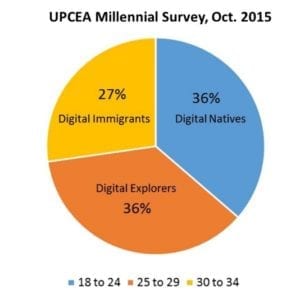
Digital immigrants (aged 30-34) are those who grew up before technology saturated the world, and learned to use technology as a tool. They remember Windows 95, eBay and dial-up Internet. Digital explorers followed and are aged 25-29. They began to see the true power of technology as part of everyday life. Controversially, as the Internet was the Wild West for them, they illegally downloaded music through Napster while watching adults use the only true smartphone at the time, the Blackberry. Digital natives (aged 18-24), are those who have grown up with technology as a crucial part of their lives and with less digital uncertainty. They connect with their friends on Facebook, check Twitter often and network professionally on LinkedIn, all from their iPhones. Millennials grew up in different times, and our survey suggests that these differences not only affect their taste in certain brands and ways of communications, but also their views on education.
Digital natives responded that being taught by a tenured professor was “extremely important” at nearly double the rate of the digital immigrants, most likely a result of their more recent college experience. Despite a potential bias of a college experience, the younger the millennial, the more they believed in the importance of the practical/workplace and academic reputation of the instructor. All three millennial segments rate the reputation of the educational institution as most important.
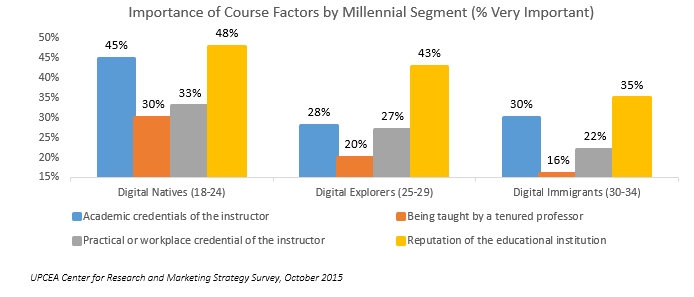
These youngest millennials are possibly more attuned to brands than any group to come before them. They’ve grown up researching and buying products online, browsing social media and have evolved to innately filter information and advertising that don’t interest them, in particular, irrelevant brands to them. They’ve been brand managers their entire lives, putting their own brand on social media for everyone to see and never posting a bad selfie on Instagram. They may want the brand that represents their education to be one that will be most representative or acceptable to them.
Proper understanding of an institution’s brand to their target millennial market segment is critical. Within the three millennial segments will be other demographics to segment on, as well as preference and usage segmentation opportunities. Online and continuing education marketers and program development staff should take note of these survey findings for more targeted opportunities.
Benchmark This! - Ethics and Integrity in Online Education
December 14, 2015
As the trend toward more online degrees and courses increases, the potential for dishonesty has also increased. Failure to proactively prevent dishonest practices could have a significant, if not cataclysmic, impact on an institution’s brand, prosperity and competitiveness in the future. Ray Schroeder, Director of UPCEA’s Center for Online Leadership, last month wrote about integrity, authentication and ethics around online classes and the need to have improved processes, regulations and technologies to prevent cheating other dishonest practices. In the spring of 2015, 141 leaders and managers of UPCEA and WCET member institutions responded to a survey on this issue.
One of the most interesting findings of the 2015 Integrity and Authentication Survey is that the potential for student dishonesty is only a minor consideration to institutions offering online courses. Most institutions rely heavily on the honor code as a deterrent to dishonesty. Institutions do acknowledge the need to not solely rely on an honor code and realize that one bad apple has the potential to impact an institution’s entire infrastructure.
A majority of respondents have yet to adopt new techniques for online tests and assessments. Fewer than half of the institutions surveyed are fully engaged in using proctoring services for their online courses. For those institutions currently using or considering using proctoring services, the simplicity, ease of use, integrity and reliability of a system in its ability to deter dishonesty are the most important features in a service. Finally, running authentication programs locally on students’ computers and video recording are seen as the least desirable features of proctoring services.
The 141 leaders and managers were asked how strongly they agreed or disagreed to a number of statements. Many did not believe that the threat of dishonesty would dissuade the field from offering more online courses and programs, but they do acknowledge the need to establish standards and enforce policies related to student dishonesty.
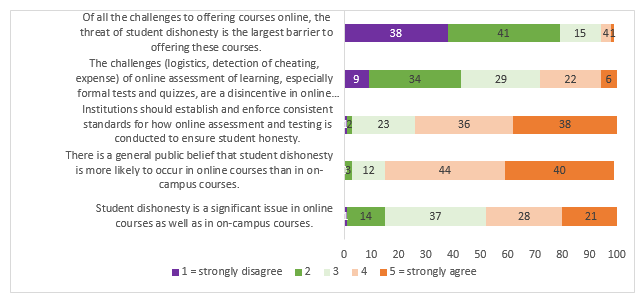
In terms of identifying where the problems may lie, leaders stated that the greatest potential problems may come from using unauthorized notes or sources (44%), unauthorized use of the web (43%), and consulting with others during a test (42%) followed by having another person taking a student’s test (38%). These percentages are perceptual and not actual occurrences.
To combat dishonesty or to maintain integrity in the process, 59% said they rely heavily on honor codes or policies and 33% said “sometimes” regarding this practice. Few required their online students to come to campus. These institutions sometimes make use of testing centers or remote online proctoring, despite the fact that many have remote monitoring as a service that they offer. Forty-three percent make use of a service, while 29% have said they either have not considered using a service or made the conscious decision to not use one. Just over one-quarter are in evaluative stages of using one or not. In terms of technological uses or tools to combat dishonesty, techniques such as the use of webcams monitored by proctors, video recording of test sessions and screen capture technologies are being used.
Read the full survey here: Ensuring the Academic Integrity of Online Tests and Assessments
Jim Fong
Director, UPCEA Center for Research and Strategy
Benchmark This! - Professionally Developing the Marketing Department
November 16, 2015
In the last Benchmark This!, it was shown that marketing departments had evolved from broadcast or publication-centered units (very typical of advertising agencies of the time), relying heavily on production and creative staff, to becoming more nimble electronic or digital marketing departments. These marketing departments employ on average 6.1 staff, down from 7.7 in 1999. With a major organizational and cultural change comes the development of new skills for marketers in transformation, as well as on-going training for new marketers entering into the higher education marketing department. This couldn’t be more evident at the UPCEA Marketing and Enrollment Management Seminar in Denver. Over 300 marketing, enrollment management and higher education leadership staff convened from November 4-6, 2015 to learn about topics such as content management, enrollment management, market research, digital marketing, dashboards and analytics and branding among other topics.
Marketers are faced with staffing and organizational structure challenges, often predicated by budgeting issues and a cultural lack of understanding or appreciation by senior leaders in higher education. Many higher education leaders often view marketing as a creative art and not necessarily a creative science, one that is strategic to the enterprise and requires alignment and integration to an institution’s portfolio. The chart to the right shows that in addition to staffing and budget issues, marketers acknowledge challenges stemming from the evolution of strategy and enrollment management and the need for analytics, dashboards and measuring return on marketing investment.
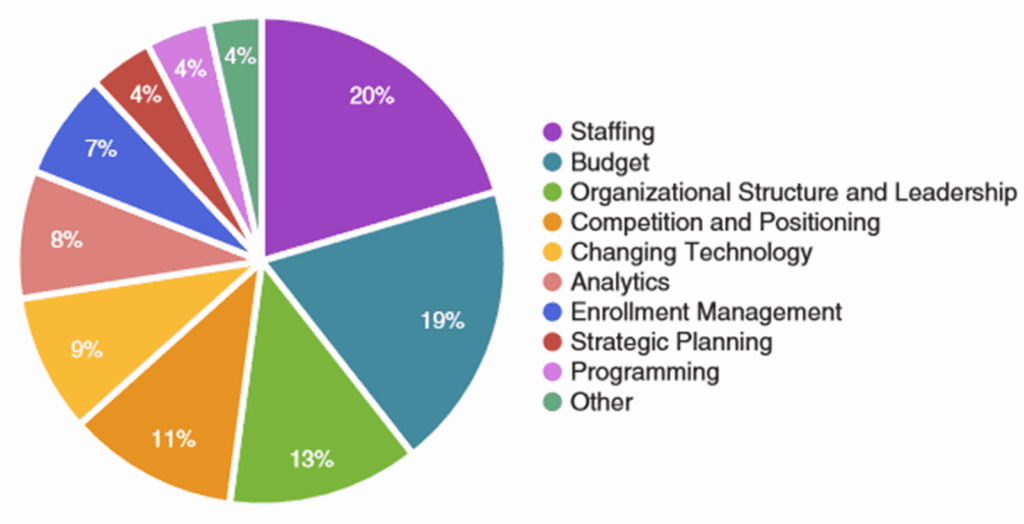
The figure below comes from UPCEA’s latest white paper Marketing Competencies and Future Challenges and shows that many marketing departments have high levels of competency in traditional marketing methods such as print advertising and copywriting, but may lack the needed skills in the use of digital media and techniques.
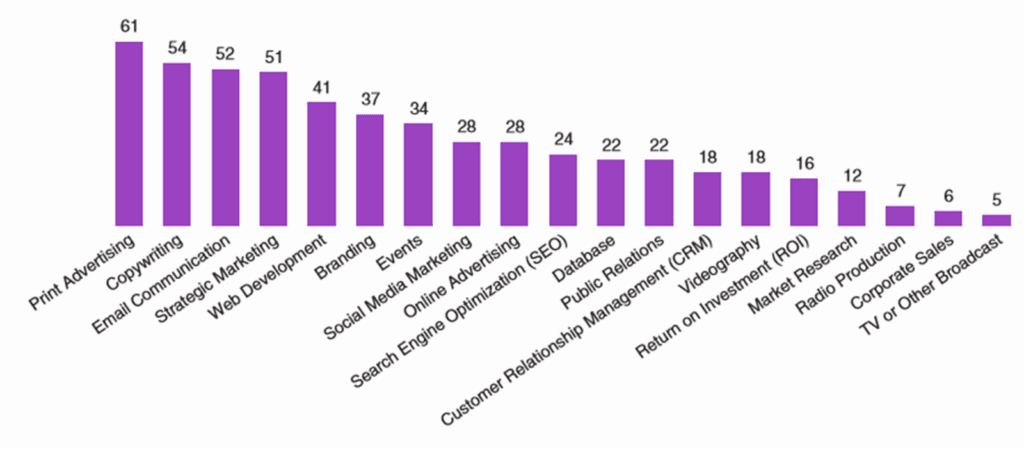
A further review of competencies shows higher competency of a number of techniques coming from institutions with five million or more of gross revenues. These marketing departments are typically larger in size or have greater budgets for outsourcing. The table that follows shows that competency for print advertising, strategic marketing and branding are higher for medium and larger institutions and their marketing departments.
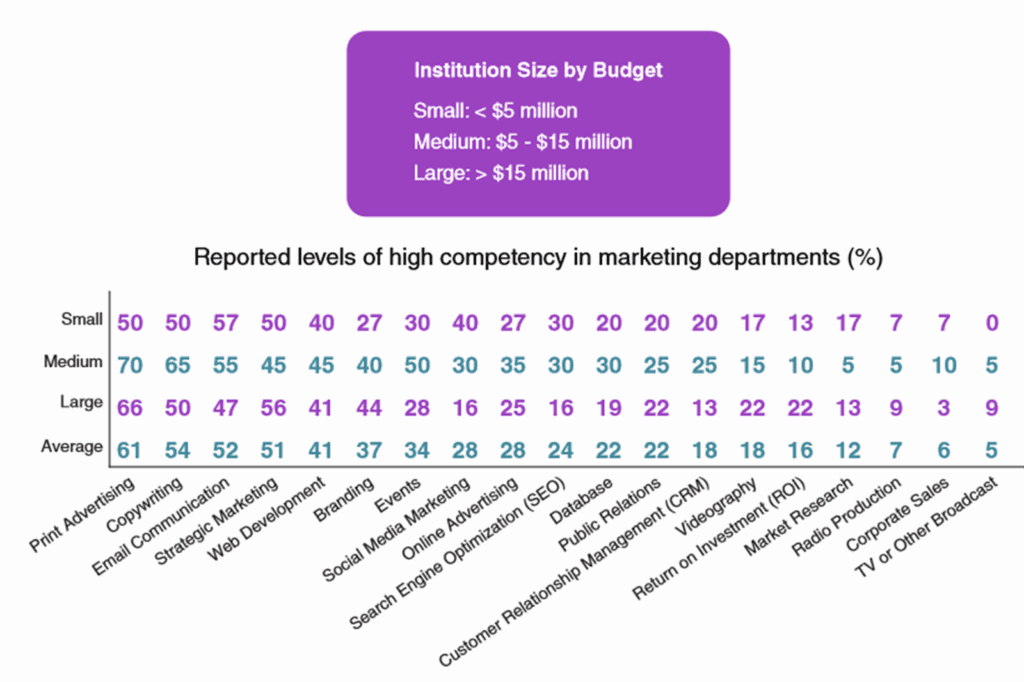
Marketers and marketing departments will continue to evolve and, while the UPCEA membership is focused on educating and training the external audience, will need to develop their own staffs. Developing staff should not be a casual duty for a higher education leader, but should be part of a plan to strategically develop, transform and retain marketing staff.
Jim Fong
Director, UPCEA Center for Research and Strategy
Benchmark This! - The Evolving Marketing Department
November 2, 2015
While faculty and technology leaders have adapted over the past two decades to the challenges and opportunities offered by online education, marketers have also had to dramatically adapt. The legacy marketing department of the nineties was primarily print and broadcast-based and relied heavily on creative services and media staff.
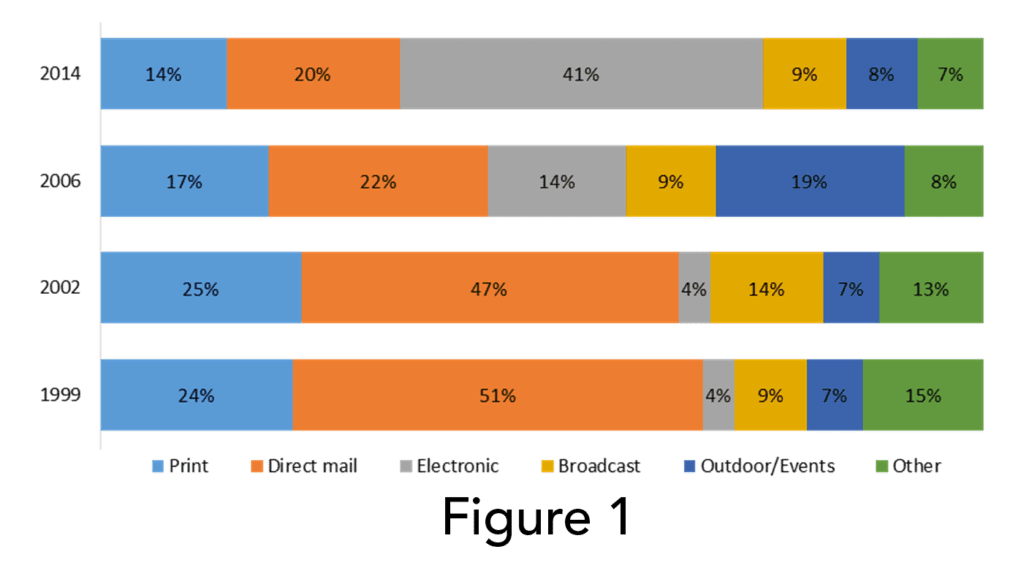
Departments marketing continuing education to current boomers leverage newspaper advertisements, radio spots, catalogs and television. Figure 1 shows that this paradigm has shifted heavily toward digital communication. Electronic media in 1999 amounted to just 4 percent of a department’s media budget. Marketing to the approximately 80 million boomers was largely confined to a limited number of broadcast television stations, a manageable set of radio stations and regional newspapers. The messaging was even easier, as boomer motivations primarily centered around the need to improve their personal and financial situations. This “me” generation was willing to take a risk by investing their time and money into the ticket to success, the bachelor’s degree or MBA.
As media budgets have shifted, so has the personnel and the skill sets available to meet today’s more complex marketing challenges, driven primarily by a largely misunderstood millennial generation, fractured media, technology-driven learning and expanded boundaries for education. Since 1999, marketing departments have shrunk from 7.7 members to 6.1, most likely due in part to outsourcing of less strategic or day-to-day needed positions to a greater emphasis on more efficient digital marketing efforts. In 1999, almost half of the staff were in creative areas such as design or copywriting. Today, that number stands at just over one in four being in a creative capacity.
While some have chosen to retire in their seventies, the boomer generation has begun their exodus from the mainstream U.S. workforce, as about one in four have hit the traditional retirement age of 65. Today’s adult learner however has become significantly more millennial (age 19 to 34), a generation which challenges the value of traditional higher education, is dependent on technology and operates in a shifting digital environment. The millennial’s motivations are often more globally-minded, focusing less on one’s self and taking a broader societal view. As a result, the marketing department has needed to shift its composition, skill set, leadership and culture. Figure 2 shows today’s marketing department has greater representation from an electronic and social media skill set. Higher education today has the onerous task of marketing to a complex millennial generation, but also embracing them into their culture, as many of the positions below are being held by millennials. In fact, in a recent analysis by EMSI, millennials represent nearly a third of all marketing positions.
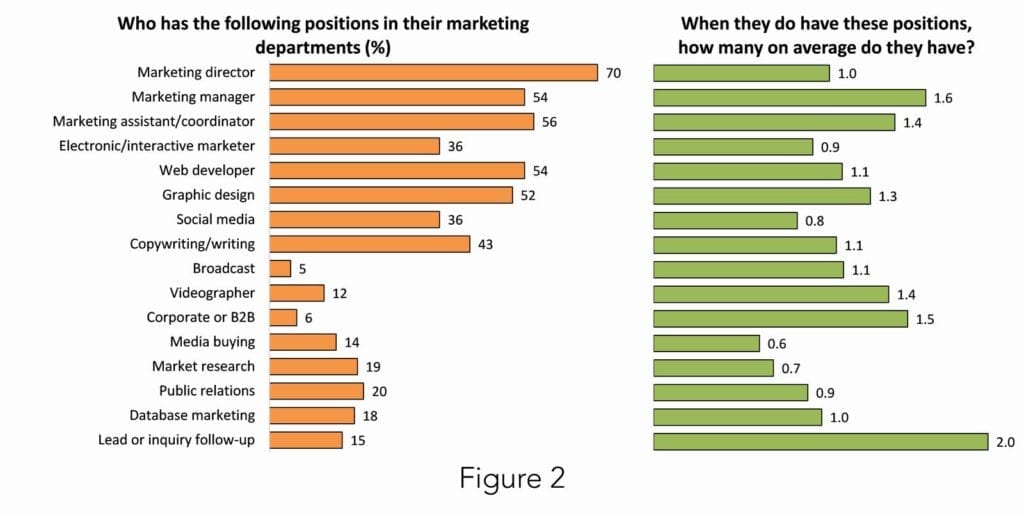
Millennials are a growing part of society, one that is taking greater control of decisions. Future editions of Benchmark This! will address their brand loyalties, motivations, perceptions toward education and true technology profile.
Jim Fong
Director, UPCEA Center for Research and Strategy
